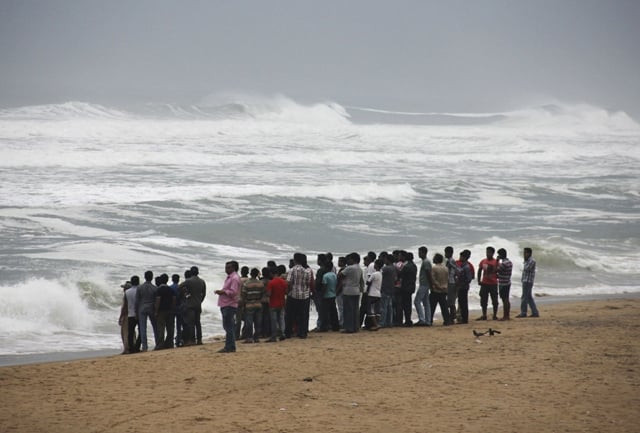
The air force sent teams to assist local disaster agencies moving people out of the path of Cyclone Phailin, expected to make landfall early on Saturday evening accompanied by a storm surge of up to three metres (10 feet).
The storm was "a very severe cyclonic storm with a maximum sustained wind speed of 210-220 kilometres an hour (130-140 mph)", the Indian Meteorological Department (IMD) said as it upgraded its warnings on Friday.
"The storm has high damage potential, considering the wind speed," IMD director general Laxman Singh Rathore told a press conference, saying it was on the cusp of being upgraded to a super-cyclone, the most powerful form.
Satellite pictures showed an intimidating cloud mass churning across the Bay of Bengal, but weather forecasters said the danger zone was about 150 kilometres (90 miles) wide and would affect coastal Orissa and neighbouring Andhra Pradesh state.
In Orissa's state capital Bhubaneswar, where rain had begun to fall and trees were bending in powerful winds, panic buying saw many shops stripped of food, with memories still strong of the 1999 storm which killed more than 8,000.
"I'm feeling scared and tense. My son is expected to arrive Sunday. Now I think he won't make it," housewife Manjushree Das told AFP. A major port on the east coast in Paradip said it had ceased all operations and would be shutting down, while local fishermen were ordered to return to the coast and seek shelter.
Tens of thousands of people were being evacuated from their homes in the areas expected to be worst affected around the town of Gopalpur where Phailin is expected to come ashore.
Orissa Chief Minister Naveen Patnaik wrote to the defence ministry appealing for help, saying that "despite preparedness by the state government, the impact of a very severe cyclonic storm requires support of the defence forces".
The air force who assisted with relief efforts after massive flooding in the Himalayas in June, said two emergency teams had been dispatched to Bhubaneswar while transport planes and helicopters are on standby.
The army and navy have been instructed to be prepared to assist the National Disaster Response Force, a statement from the defence ministry said.
The cyclone, currently about 400 kilometres (310 miles) off the coast, has strengthened dramatically in recent days as it heads for an impoverished part of India dotted with shanties and huts with thatched roofs.
It is travelling at about 15 kilometres an hour and measures about 400-500 kilometres in length and breadth, the IMD said.
"We have already deployed our entire disaster mitigation force on pre-storm initiatives," special relief commissioner for Orissa, Pradipta Mohapatra, told AFP.
The 1999 super-cyclone which knocked out power lines, railway links and devastated forest areas packed far higher speeds of up to 300 kilometres an hour and led to a a storm surge of six metres.
A government report on the disaster published in 2009 put the human death toll at 8,243, while 445,000 livestock perished.
"We are fighting against nature. We are better prepared this time, we learnt a lot from 1999," the state's Disaster Management Minister Surya Narayan Patra told NDTV.
"The first priority will be to save people's lives, ensure food and electricity," Patra said.
Cyclones typically form in the Bay of Bengal around this time of year at the end of the steamy monsoon season when the sea temperatures are at their highest.
"The devastation is expected to be less than in 1999," said Mahesh Palawat, chief meteorologist at India's biggest private forecaster Skymet.
"This time we have the Indian Meteorological Office pinpointing the area of contact quite accurately and people are taking steps," he told AFP.
The last major storm to strike India was last January when Cyclone Thane hit the southern Indian state of Tamil Nadu, killing 42 people.


















COMMENTS
Comments are moderated and generally will be posted if they are on-topic and not abusive.
For more information, please see our Comments FAQ